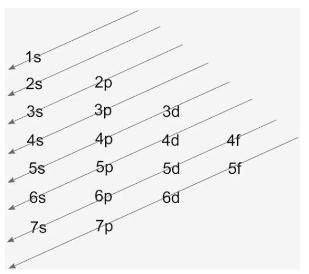
What is the electron configuration for $Z{{n}^{2+}}$ ?
Answer
521.1k+ views
Hint: Zinc has an atomic number of 30. It has the atomic number of 33. Zinc is the element of the d-block. Aufbau proposed the filling of electrons. The electrons are filled in s, p, d, and f orbitals, according to the levels of energy in various shells.
Complete answer: Electronic configuration of any element tells us the total number of electrons in that atom or the atomic number of that element. Electronic configuration of any element consists of filling the orbital with electrons. The filling of electrons in various orbitals is according to a principle of Aufbau. The filling takes place in s, p, d, and f subshells. These subshells are written along with the number of shells, like 1,2, or 3.
The diagrammatic representation of the Aufbau diagram is as follows:

The arrows denote the order of the filling of electrons. s can accommodate 2 electrons, p can have 6, d can have 10, while f can have 14 electrons filled.
Now, given is the element $Z{{n}^{2+}}$, which is zinc with 2+ charges. The 2+ charge denotes that zinc has loosened 2 electrons from its valence shell. The atomic number of zinc is 30, so 30 electrons are present in its neutral state, so configuration in neutral state will be:
Zn =$1{{s}^{2}}2{{s}^{2}}2{{p}^{6}}3{{s}^{2}}3{{p}^{6}}3{{d}^{10}}4{{s}^{2}}$ , this is the electronic configuration of Zinc.
It can also be written by writing a noble gas (argon) and then writing the remaining electrons as,
Zn = [Ar]$3{{d}^{10}}4{{s}^{2}}$, argon with 18 electrons is added and remaining electrons are written as it is.
Now, zinc loses 2 electrons to form $Z{{n}^{2+}}$, so removing 2 electrons from the $4{{s}^{2}}$ becomes total 28 electrons, so the configuration of $Z{{n}^{2+}}$ becomes,
$Z{{n}^{2+}}$= $1{{s}^{2}}2{{s}^{2}}2{{p}^{6}}3{{s}^{2}}3{{p}^{6}}3{{d}^{10}}$ or [Ar]$3{{d}^{10}}$
Hence, the electronic configuration of $Z{{n}^{2+}}$ is written as $1{{s}^{2}}2{{s}^{2}}2{{p}^{6}}3{{s}^{2}}3{{p}^{6}}3{{d}^{10}}$ or [Ar]$3{{d}^{10}}$
Note: Another way to show the electronic configuration is writing it without sub shells (s, p, d, f). It is written showing the electrons in shells of K, L, M, N, that can have 2, 8, 18, 32 electrons respectively. So $Z{{n}^{2+}}$ will have configuration of 2, 8, 18.
Complete answer: Electronic configuration of any element tells us the total number of electrons in that atom or the atomic number of that element. Electronic configuration of any element consists of filling the orbital with electrons. The filling of electrons in various orbitals is according to a principle of Aufbau. The filling takes place in s, p, d, and f subshells. These subshells are written along with the number of shells, like 1,2, or 3.
The diagrammatic representation of the Aufbau diagram is as follows:

The arrows denote the order of the filling of electrons. s can accommodate 2 electrons, p can have 6, d can have 10, while f can have 14 electrons filled.
Now, given is the element $Z{{n}^{2+}}$, which is zinc with 2+ charges. The 2+ charge denotes that zinc has loosened 2 electrons from its valence shell. The atomic number of zinc is 30, so 30 electrons are present in its neutral state, so configuration in neutral state will be:
Zn =$1{{s}^{2}}2{{s}^{2}}2{{p}^{6}}3{{s}^{2}}3{{p}^{6}}3{{d}^{10}}4{{s}^{2}}$ , this is the electronic configuration of Zinc.
It can also be written by writing a noble gas (argon) and then writing the remaining electrons as,
Zn = [Ar]$3{{d}^{10}}4{{s}^{2}}$, argon with 18 electrons is added and remaining electrons are written as it is.
Now, zinc loses 2 electrons to form $Z{{n}^{2+}}$, so removing 2 electrons from the $4{{s}^{2}}$ becomes total 28 electrons, so the configuration of $Z{{n}^{2+}}$ becomes,
$Z{{n}^{2+}}$= $1{{s}^{2}}2{{s}^{2}}2{{p}^{6}}3{{s}^{2}}3{{p}^{6}}3{{d}^{10}}$ or [Ar]$3{{d}^{10}}$
Hence, the electronic configuration of $Z{{n}^{2+}}$ is written as $1{{s}^{2}}2{{s}^{2}}2{{p}^{6}}3{{s}^{2}}3{{p}^{6}}3{{d}^{10}}$ or [Ar]$3{{d}^{10}}$
Note: Another way to show the electronic configuration is writing it without sub shells (s, p, d, f). It is written showing the electrons in shells of K, L, M, N, that can have 2, 8, 18, 32 electrons respectively. So $Z{{n}^{2+}}$ will have configuration of 2, 8, 18.
Recently Updated Pages
Why are manures considered better than fertilizers class 11 biology CBSE

Find the coordinates of the midpoint of the line segment class 11 maths CBSE

Distinguish between static friction limiting friction class 11 physics CBSE

The Chairman of the constituent Assembly was A Jawaharlal class 11 social science CBSE

The first National Commission on Labour NCL submitted class 11 social science CBSE

Number of all subshell of n + l 7 is A 4 B 5 C 6 D class 11 chemistry CBSE

Trending doubts
10 examples of friction in our daily life

One Metric ton is equal to kg A 10000 B 1000 C 100 class 11 physics CBSE

Difference Between Prokaryotic Cells and Eukaryotic Cells

1 Quintal is equal to a 110 kg b 10 kg c 100kg d 1000 class 11 physics CBSE

State the laws of reflection of light

Explain zero factorial class 11 maths CBSE




